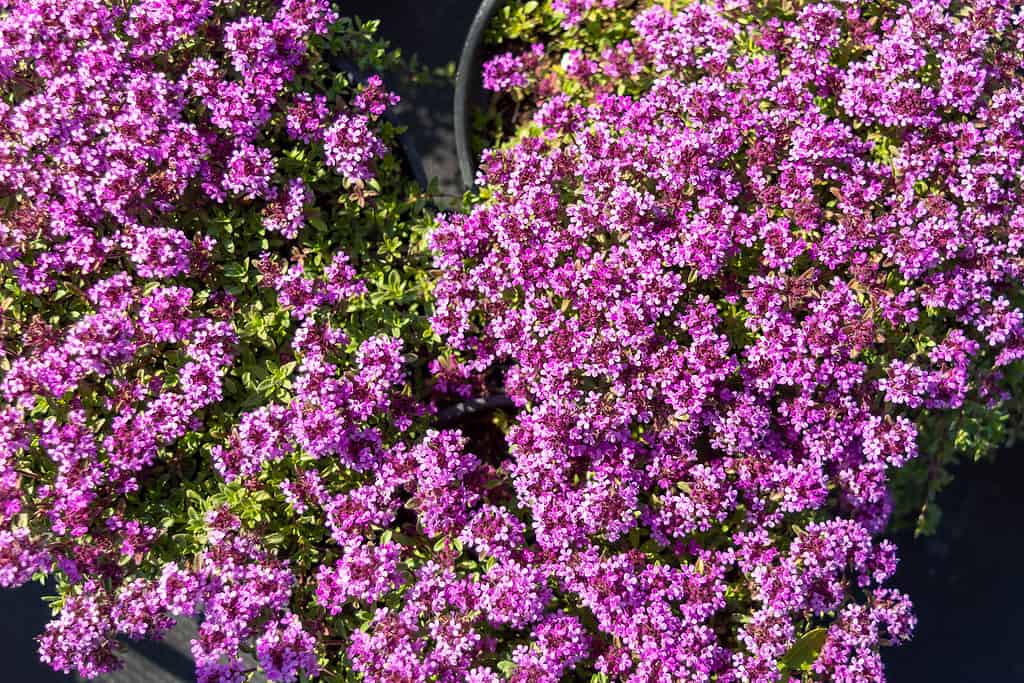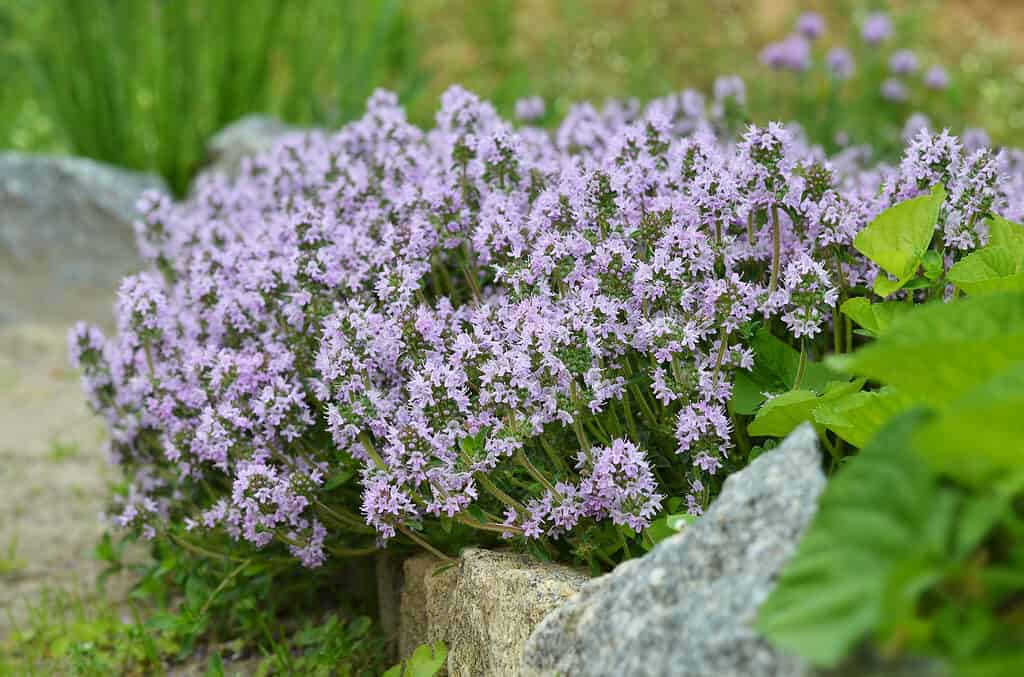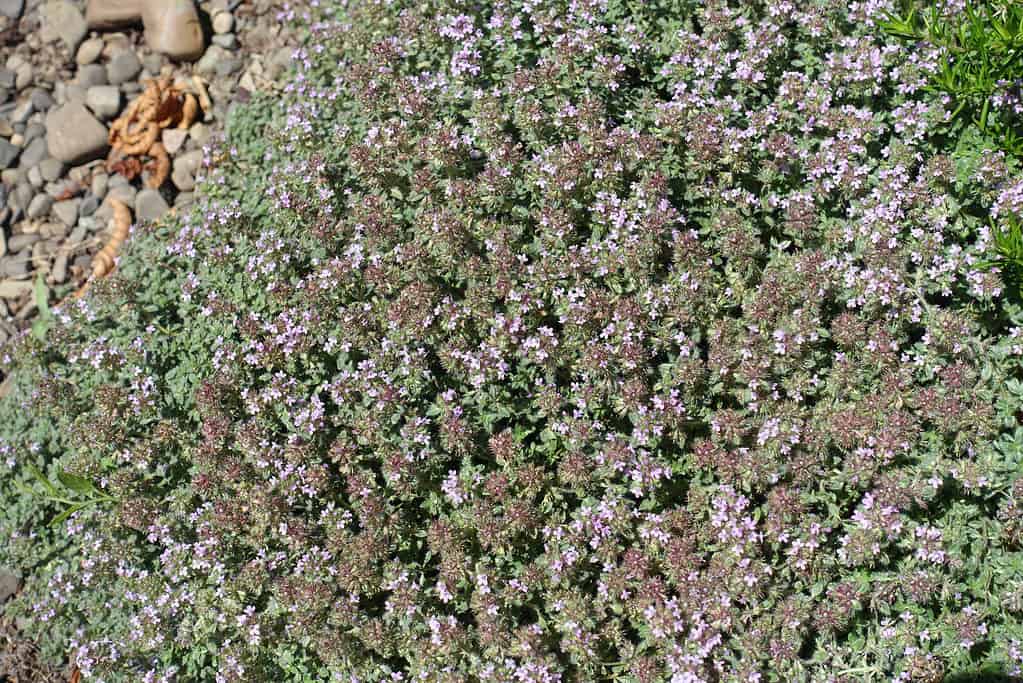Many beautiful plants in the world are shockingly similar. These similarities create confusion for gardeners and plant enthusiasts trying to plan their garden or identify plants in the wild.
Creeping thyme and elfin thyme are commonly confused with one another, and people often use their names interchangeably. While these plants are closely related, there are some subtle differences. Let’s explore creeping thyme vs. elfin thyme and what makes them unique.
Comparing Creeping Thyme vs. Elfin Thyme
| Creeping Thyme | Elfin Thyme | |
|---|---|---|
| Classification | Thymus praecox, Thymus serpyllum | Thymus serpyllum ‘Elfin’ |
| Alternative Names | elfin thyme, leprechaun thyme, creeping thyme coccineus, mother-of-thyme | breckland thyme, miniature thyme |
| Origin | Europe | Europe, North Africa |
| Description | Petite purple and white flowers growing 3-6 inches tall with limitless sprawl. Leaves are waxy green and elliptical with fibrous hairs. It tends to have a higher ratio of blooms to foliage. | Petite magenta, pink, purple, and white flowers growing 1-3 inches tall and spreading 1-1.5 feet per plant. Leaves are waxy green and elliptical. The ratio of foliage to florals is balanced. |
| Uses | Primarily used as ground cover. Not appropriate for culinary use. | Primarily used as ground cover. Not appropriate for culinary use. |
| Growth Tips | Propagate from existing plants and root indoors. When roots show, plant in well-draining, loamy soil in full sun in USDA Zones 5-8. | Propagate from existing plants and root indoors. When roots show, plant in well-draining, loamy soil in full sun in USDA Zones 4-9. |
| Interesting Features | Ideal for edging gardens and walkways. Will emit an herbaceous scent when stepped on. | Ideal for edging gardens and walkways. Will emit an herbaceous scent when stepped on. |
Creeping Thyme vs. Elfin Thyme: Key Differences
The primary difference between creeping thyme and elfin thyme is that “creeping thyme” is used to describe several different species and cultivars of thyme, whereas elfin thyme is a single cultivar.
Many avid gardeners consider Thymus praecox the original species of creeping thyme, which is why it’s often called mother-of-thyme. However, the term is also used to describe the species Thymus serpyllum, particularly where Thymus praecox doesn’t grow.
In this article, we’ll focus on the differences between Thymus praecox and Thymus serpyllum.

The original species of creeping thyme is
Thymus praecox.
©iStock.com/Pimanova Marina
Creeping Thyme vs. Elfin Thyme: Classification
Creeping thyme and elfin thyme are both members of the Thymus genus, which is home to 350 species of thyme. This genus includes all of the species of ornamental and edible variations.
The original species of creeping thyme is Thymus praecox. The word praecox is Latin for “very early” or “primitive,” which refers to this species’ ancient origins.
Elfin thyme is Thymus serpyllum ‘Elfin.’ The Latin word serpyllum translates to “brush,” as this plant is classified as a shrub. The ‘Elfin” cultivar was chosen for its miniature, delicate blooms, which tend to be smaller than other thyme cultivars.

Elfin thyme (
Thymus serpyllum) is classified as a shrub with miniature, delicate blooms, which tend to be smaller than other thyme cultivars.
©iStock.com/Orest Lyzhechka
Creeping Thyme vs. Elfin Thyme: Origin
Creeping thyme is primarily found across Europe, particularly in the Mediterranean region. Elfin thyme can also be found in this area but extends down into North Africa. The common habitat contributes to the interchangeable names and confusion surrounding these species.
Creeping Thyme vs. Elfin Thyme: Description
Creeping thyme has blue-green elliptical leaves with fibrous hairs and delicate purple and white flowers. This plant typically grows no more than three inches tall, but it will grow up to six inches in favorable environments. This species of creeping thyme has showy blooms and will continue to expand outward until it reaches a barrier.
Elfin thyme also has blue-green elliptical leaves and flowers ranging from purple to white. The key difference is in the size of the blooms. Elfin thyme tends to have more visible foliage than creeping thyme, with a balanced ratio of flowers to leaves. Moreover, Elfin thyme will also spread outward, though individual plants tend to stop between one and two feet from their base.

Elfin thyme tends to have more visible foliage than creeping thyme and grows outward with a balanced ratio of flowers to leaves.
©iStock.com/Yuliia Bilousova
Creeping Thyme vs. Elfin Thyme: Uses
Both creeping thyme and elfin thyme are primarily used as ground cover. These plants are great grass alternatives and edging solutions. Plant these between paving stones for easy maintenance, or use them to edge your gardens.
One of the nice features of both creeping thyme and elfin thyme is the herbaceous aroma they emit when stepped on. This is a nice feature for gardeners walking through the yard and also deters rabbits and deer from foraging in gardens. The blooms are also pollinator-friendly.
While creeping thyme and elfin thyme are edible, they aren’t ideal for culinary purposes. Instead, opt for common thyme (Thymus vulgaris) or lemon thyme (T. x citriodorus).

One of the nice features of both creeping thyme and elfin thyme is the herbaceous aroma they emit when stepped on.
©iStock.com/apugach
Creeping Thyme vs. Elfin Thyme: Growth Tips
Both creeping thyme and elfin thyme are difficult to grow from seed. Experts recommend getting cuttings of established plants and rooting them indoors. Alternatively, you can purchase cuttings or seedlings from a garden store.
Plant your creeping thyme or elfin thyme in full sun, in well-draining soil. Both species prefer frequent watering and humidity. Avoid planting them near crops with minimal weed resistance, as these creeping shrubs can overpower the roots.
The photo featured at the top of this post is ©
Sources
- NC State Extension, Available here: https://plants.ces.ncsu.edu/plants/thymus-serpyllum-elfin/
- NC State Extension, Available here: https://plants.ces.ncsu.edu/plants/thymus-praecox/
Thank you for reading! Have some feedback for us? Contact the AZ Animals editorial team.






